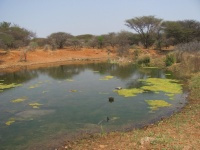
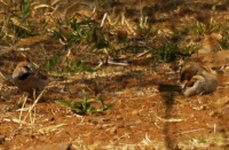
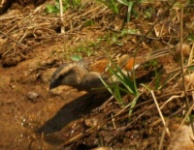
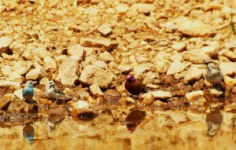
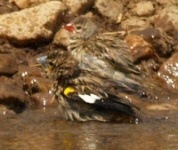
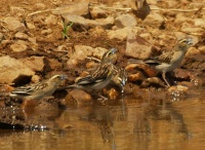
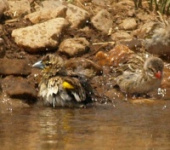
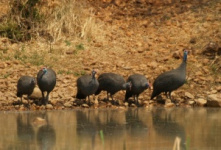
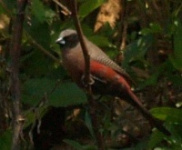
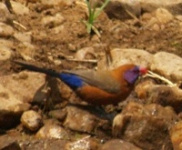
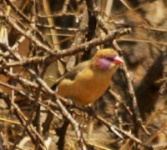
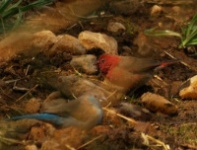
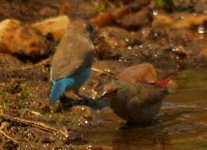
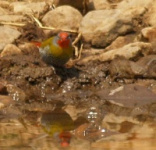
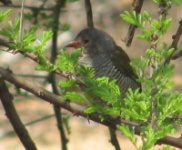
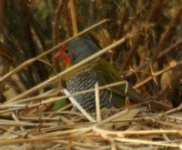
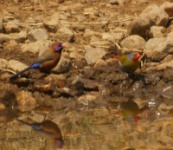
In the October school holidays during 2010 while on holiday at Mabalingwe Nature Reserve we drove through to Polokwane for the day to visit the Bird Sanctuary and the Game Reserve. One of my objectives was to see the Short-clawed Lark that is resident in this area (we stopped at the Shell Ultra City on the N1 just south of Polokwane hoping to see it early that morning but did not find it). The Game Reserve is situated south of the town at the intersection of Dorp Street and the R71 to Tzaneen! We followed directions from Birding Gauteng (Chapter 87) and realised that an 11am start for birding is clearly less than ideal as we saw very little from the entrance gate to the first waterhole apart from Common Ostrich, Fork-tailed Drongo and Speckled Mousebird.
But things changed when we arrived at the Aloe Ridge Waterhole and settled down in the shade to watch who would come and drink - and boy, were we royally entertained by Swainson's Spurfowl, Southern Grey-headed Sparrow, Crimson-breasted Shrike, Red-billed Quelea, Great Sparrow, Tawny-flanked Prinia, Blue Waxbill, Violet-eared Waxbill, Scaly-feathered Finch, Green-winged Pytilia, Neddicky, Black-faced Waxbill, White-winged Widowbird, Southern Masked Weaver, Helmeted Guineafowl, Laughing Dove and Marico Flycatcher. Here are some pics that we took in this area:
We then headed off on the Main Loop road (this is supposed to be one of the three key spots in the reserve where the Short-clawed Lark is found but we lucked out) we saw White-browed Sparrow-Weaver, Cape Turtle-Dove, Southern Grey-headed Sparrow, Namaqua Dove, Black-faced Waxbill, Cape Sparrow, Helmeted Guineafowl, Crimson-breasted Shrike, Tawny-flanked Prinia, Kalahari Scrub-Robin, Swainson's Spurfowl, Sabota Lark (I hoped this couple were Short-clawed but it was not so), Cape Glossy Starling, Common Ostrich, Lourie, Black-shouldered Kite, Common Fiscal, Marico Flycatcher, Speckled Mousebird, White-browed Scrub-Robin and Magpie Shrike. Here are some pics that we took in this area:
At one point on this Main Loop we arrived at an interesting site around a massive tree and here we saw: White-browed Sparrow-Weaver, Green-winged Pytilia, Pin-tailed Whydah (looks like it is in transitional plumage or it is a juvenile) and Violet-eared Waxbill.
Not much further along the road I spotted this little chap in a tree and despite it's dull plumage I am tentatively identifying it as Levaillant's Cisticola:
We stopped to picnic outside the Dries Abrahamse Lapa (which is unfortunately not open to the public) and at the little dam nearby spotted a Brown-hooded Kingfisher:
Our next stop was the Thokudu waterhole (which was deserted apart from a Hamerkop), the only spot in the Reserve with a bird hide, before heading off on the Tsessebe Drive. We screeched to a halt at the sight of a little raptor in a tree that we initially mistakenly identified as Gabar Goshawk - it turned out to be Lizard Buzzard - but a magnificent sighting it was until someone came racing past and it took off. Lucking we saw it perched again (it or a mate) about 100 metres away from the initial spot. This helped us get pics of the bird from both sides.
We saw a raptor soaring high overhead that was identified as Black-chested Snake Eagle and Kalahari Scrub-Robin and Rattling Cisticola were the only other sightings on the whole route - and sadly we passed the second location where the Short-clawed Lark has been sighted with no luck again.
The Warthog picnic site was a great stop over before heading back towards the main entrance. Here we saw Yellow-billed Hornbill, Southern Boubou (with a broken beak), Black-faced Waxbill, Blue Waxbill, Crimson-breasted Shrike, Brubru and Southern Masked Weaver. Sadly we passed the last spot in the Reserve where the Lark is supposed to be waiting for a photo shoot and again lucked out. It was sad!!!
Here are a few pics of the relatively few mammals that we saw in the Reserve:
But there were two more possibilities - between 2 and 3 kilometers along the R71 towards Tzaneen is another location for the Lark - but this too yielded nothing. There was one last possibility - at the intersection of the R71 and the N1. We stopped around 500 meters before we got to the N1 (driving west on the R71) and saw lots of birds in the open area next to the road but no sign of a Lark. Was that it??? As we took what I thought was the N1 highway (but as it turns out it was the R101 and not the N1) - and about 200 meters from the intersection I spotted a Lark on the side of the road and fired off a quick shot of two. It was some distance away from the car and my 300mm zoom lens was not going to get me a shot that would help with an id.
We spotted a second Lark and noticed that one of them was snacking on a large insect while the other was foraging in the grass on the side of the road. Again a few fuzzy pics - not the shot that I needed!!! And I still had no way to know whether it might be Rufous-naped or Sabota which are common in the area!
I reversed and (as usual) the bird took off and flew off to a tree about 75 meters from the side of the road - on the other side of a fence. Great, I thought - there goes my chance of getting a shot! All I got was this shot of the bird perched on top of the bush:
Considering carefully the ethics of what I was about to do, and balancing it with my desperation to get a shot as proof of what we had seen, I played the Short-claw's call (from Roberts multimedia) on my cell phone. Immediately it began to do it's distinctive aerial display - this is how Etienne Marais and Faansie Peacock describe it in Birding Gauteng on page 297: "In typical Certhilauda style, males fly almost vertical up to a height of 10 m and then dive down with wings closed and long tailed fanned open, while uttering a long whistle." It was amazing to watch this display. Hey, if I was a female Short-clawed I would be impressed with this chaps aerobatics! I wished I had my video camera to catch the action. And next thing I knew it flew to the fence on the side of the road and before long it flew to a little rock right next to our car and I was finally able to get the shots that I wanted.
We decided to leave the Larks in peace and made our way to the Shell Ultra City for a cup of Steers coffee! Pity there was no Seattle Coffee shop at the site - it was certainly a moment for serious celebration for what we had just witnessed!!!
Here are the GPS co-ordinates for this spot: 23°56'49.64"S, 29°24'39.95"E. I guess we got lucky but taking the R101 by mistake!!! And that accounts for us taking a scenic route back towards Bela Bela - given that we were on the alternative route for a while. On our way back we saw African Spoonbill, Pied Crow, Red-billed Hornbill, Brown-hooded Kingfisher, African Palm Swift, House Sparrow, Southern Masked Weaver, Common Fiscal, Black-shouldered Kite, Helmeted Guineafowl, Cattle Egret, Black-headed Heron, Natal Francolin, Grey Heron, Fork-tailed Drongo, Magpie Shrike and Lourie. The day ended with a braai with friends and by the time we retired for the night we were totally finished but truly fulfilled!
What an awesome day of birding it had been - a total of 82 bird species seen on the day with 42 recorded at Polokwane Game Reserve and a lifer in the Short-clawed Lark.